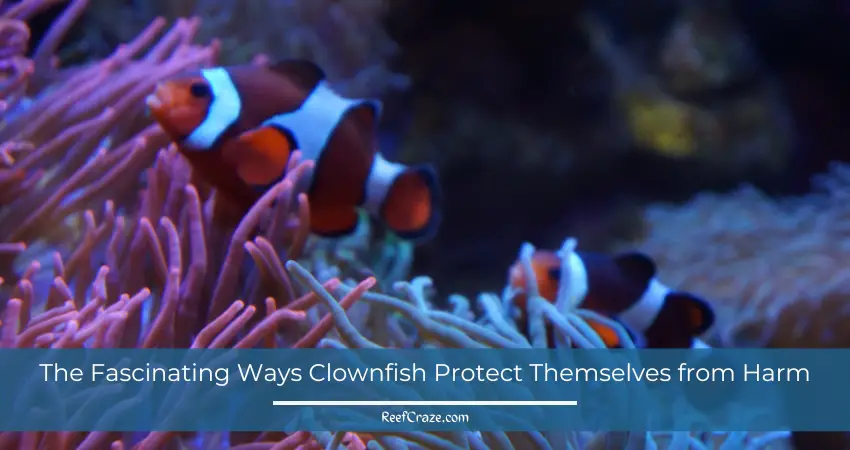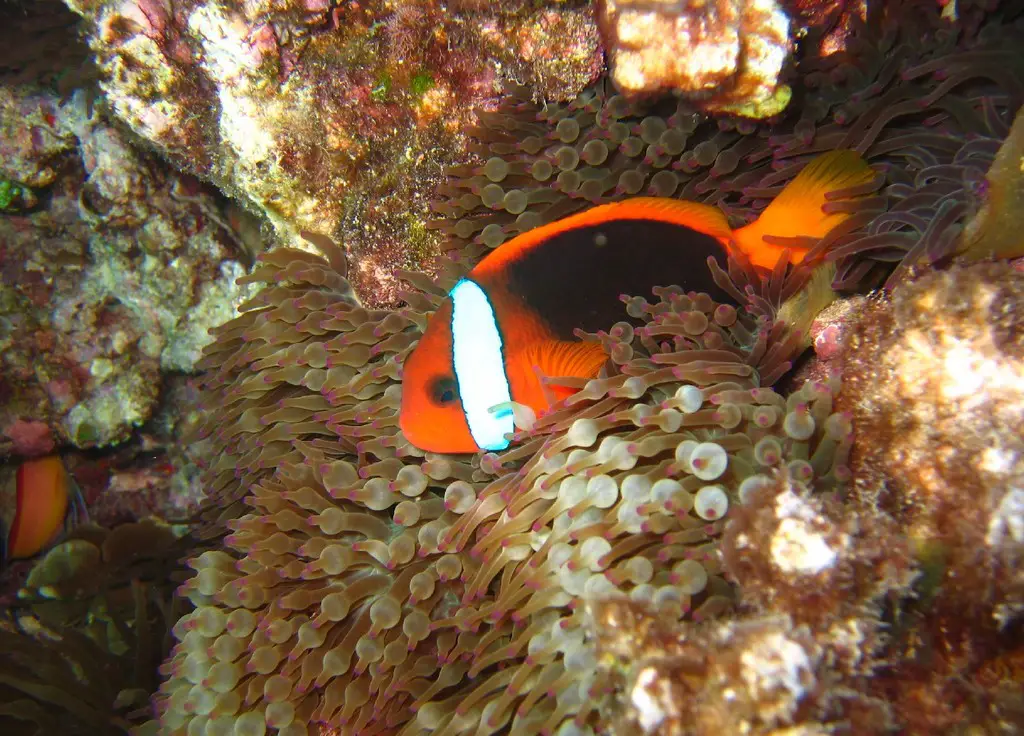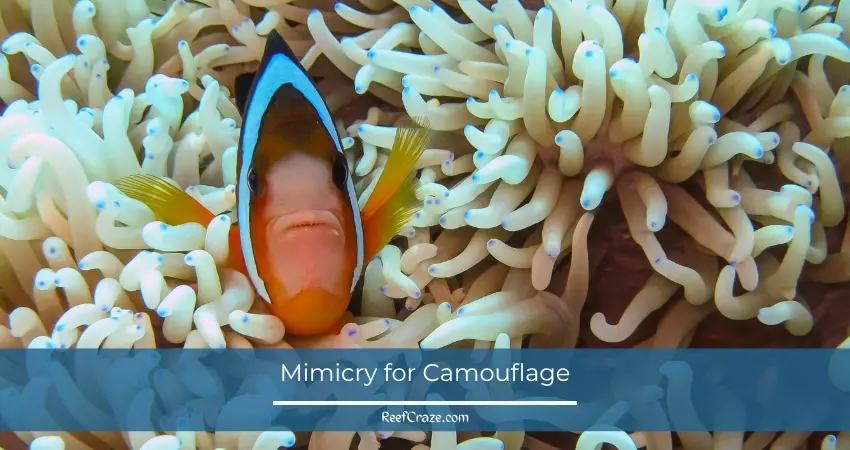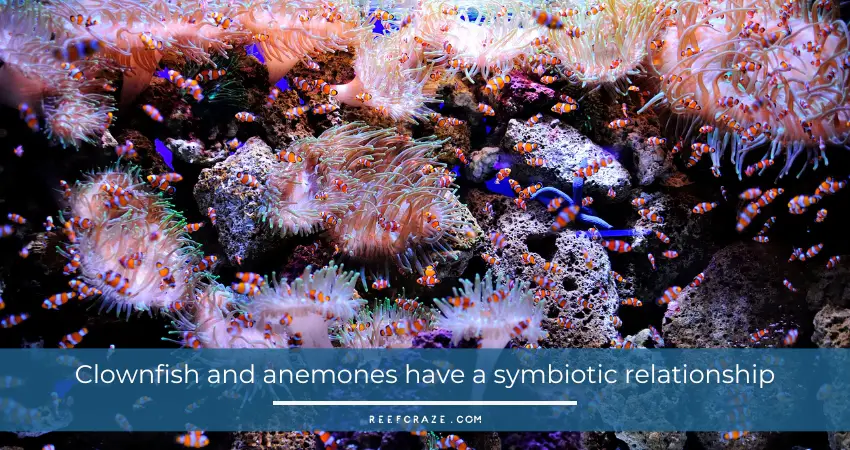Clownfish, also known as anemonefish, are a small, brightly colored species of fish native to the waters of the Indian and Pacific Oceans. They are typically found in shallow coral reefs, where they live in small groups consisting of a mating pair and their offspring. Clownfish are generally non-migratory.
In addition to their striking appearance, clownfish have a number of defense mechanisms that they use to protect themselves from predators. In this article, we will explore the various ways in which clownfish defend themselves, including their use of physical and behavioral defenses, as well as their symbiotic relationships with other species.

1. Physical defenses of clownfish
Clownfish are often brightly colored, with patterns of stripes or spots on their bodies. The coloration of these fish can range from orange and red to yellow and white.
Size and Coloration as Defense Mechanisms
One physical characteristic that helps clownfish defend themselves is their small size. Clownfish are only about 4 inches long, which makes them difficult for larger predators to catch.
The bright colors and distinctive patterns of clownfish are thought to serve as a warning to potential predators that the fish is toxic or distasteful. This is known as “aposematism,” and it is a common defense mechanism used by many species of animals.
In the case of clownfish, it is believed that their bright colors and patterns serve as a visual deterrent to predators such as larger fish and invertebrates.
Toxins In The Skin As A Deterrent
Clownfish secrete toxins through their skin as a defense mechanism against predators. These toxins can cause a burning sensation or other unpleasant effects if ingested, which can deter predators from attacking.
The toxins produced by clownfish are produced by glands in their skin, and they can be released when the fish is threatened or agitated. These toxins are not lethal, but they can be unpleasant for predators and can discourage them from attacking the clownfish.
The presence of toxins in the skin of clownfish is not unique to this species. Many other animals, such as poison dart frogs and pufferfish, also produce toxins in their skin as a defense mechanism.

The production of toxins in the skin is an example of an evolutionary adaptation that has helped clownfish survive in their natural habitat. By deterring predators, clownfish are able to protect themselves and increase their chances of survival.
It is worth noting that the toxins produced by clownfish are not harmful to humans and are not present in the flesh of the fish. Therefore, clownfish can be safely kept as pets and are not a danger to humans. However, it is important to handle clownfish with care and not to agitate them, as they may release their toxins if they feel threatened.
2. Behavioral adaptations for self-defense
Territorial Behavior and Hiding
Clownfish are known for their territorial behavior, which involves aggressively defending their territory from other clownfish and potential predators. This behavior can help clownfish protect themselves from threats and increase their chances of survival.
Clownfish establish territories within coral reefs and will defend these territories from intruders. They use a variety of tactics, such as chasing, biting, and vocalizing, to deter other clownfish and potential predators. This territorial behavior helps clownfish establish dominance over a particular area and secure resources, such as food and shelter.
Mimicry for Camouflage
Mimicry is the ability of an animal to blend in with its surroundings in order to avoid detection. Clownfish use mimicry as a defense mechanism to protect themselves from predators by blending in with their surroundings and avoiding detection.
Clownfish are masters of mimicry, using their coloring and patterning to blend in with the coral reefs they inhabit. They have a variety of color patterns, including stripes, spots, and solid colors, which can help them blend in with their surroundings. For example, a clownfish with stripes may blend in with a coral reef that has a lot of vertical lines, while a clownfish with spots may blend in with a coral reef that has a lot of small, round features.

The ability to mimic their surroundings allows clownfish to avoid detection by potential predators. This can be especially useful when a clownfish is vulnerable, such as when it is resting or feeding. By blending in with their surroundings, clownfish can reduce their chances of being noticed by predators and increase their chances of survival.
In addition to coloring and patterning, clownfish also use their behavior to mimic their surroundings. They are known to mimic the movements of other animals, such as anemones, in order to blend in with their surroundings and avoid detection.
Ability to “play dead” as a defense mechanism
In some cases, clownfish may also use a behavior known as “tonic immobility” as a defense mechanism. When threatened, they may roll onto their side and appear to be “dead,” which can sometimes fool predators into thinking that the fish is not worth attacking.
Unique swimming pattern
Clownfish are able to swim quickly when threatened, allowing them to escape from predators. This ability to swim quickly is an important defense mechanism for clownfish, helping them to avoid confrontations with larger or more powerful animals.
Clownfish are small, agile fish that are well-suited for fast swimming. They have a streamlined body shape and powerful fins that allow them to move quickly through the water. When threatened by a predator, clownfish can swim away quickly in order to escape.
They are known to swim erratically when threatened, making it difficult for predators to predict their movements and catch them. This behavior can be especially effective when combined with the clownfish’s ability to hide in crevices or among the tentacles of anemones.
3. Mutualistic relationships with other species
Symbiotic Relationship With Anemones
Clownfish have a mutualistic relationship with anemones, which are stinging, stationary marine animals. This relationship provides protection for both the clownfish and the anemones.
The relationship between clownfish and anemones begins when a clownfish takes up residence within an anemone. The anemone provides the clownfish with a safe place to hide and a source of food, while the clownfish provides the anemone with protection from predators.

The anemones’ tentacles contain stinging cells called nematocysts, which are used to capture prey and deter predators. When a clownfish takes up residence within an anemone, the anemone’s tentacles do not sting the clownfish. This allows the clownfish to hide safely within the anemone and avoid being seen by predators.
In return for the protection provided by the anemone, clownfish help to defend the anemone from predators. They will aggressively chase away any animal that comes too close to the anemone, helping to keep the anemone safe.
Cleaning Behavior as a Mutualistic Relationship
In addition to their mutualistic relationship with anemones, clownfish also engage in a cleaning behavior that serves as a mutualistic relationship with other species. This behavior involves the clownfish removing parasites and dead skin from larger fish like Groupers or Angelfish.
The cleaning behavior of clownfish is beneficial for both the clownfish and the larger fish. For the clownfish, the cleaning behavior provides a source of food, as they feed on the parasites and dead skin they remove. In addition, the cleaning behavior helps to maintain the health of the larger fish, as parasites and dead skin can harbor diseases and impair the larger fish’s ability to swim and breathe.
In return for the cleaning services provided by the clownfish, the larger fish provide the clownfish with protection. The larger fish will often remain still while being cleaned, allowing the clownfish to approach them without fear of being attacked. This protection can be especially important for clownfish, as they are small and vulnerable to predators.
Clownfish also have a hierarchical social structure, with a dominant male and female in each group. The dominant pair is responsible for protecting the group from predators, and they will use aggressive behavior to ward off potential threats. This can help to keep the group safe from attack.
In addition to these behaviors, clownfish also have physical adaptations that help them to protect themselves from predators. They have a small, compact body that makes it difficult for larger fish to swallow them whole. They also have sharp spines on their fins that can make them difficult to eat. These physical features can provide additional protection for the fish.
Wrapping Up
In conclusion, clownfish have a variety of defense mechanisms that help them protect themselves from predators and increase their chances of survival in their natural habitat. These defense mechanisms include physical characteristics such as their small size and bright coloration, as well as behavioral adaptations such as territorial behavior and mimicry. In addition, clownfish engage in mutualistic relationships with other species, such as anemones and larger fish, which provide protection and other benefits.
Overall, the various defense mechanisms used by clownfish illustrate the importance of self-defense for the survival of animals in their natural habitat. By understanding these defense mechanisms, we can gain a greater appreciation for the adaptations that allow clownfish to thrive in their coral reef environments.
References:
- “Amphiprion percula.” Integrated Taxonomic Information System, https://www.itis.gov/servlet/SingleRpt/SingleRpt?search_topic=TSN&search_value=163874#null.
- Fautin, Daphne G. “Anemonefish.” Encyclopedia of Life, http://eol.org/pages/206089/overview.
- “Symbiosis.” Encyclopedia Britannica, https://www.britannica.com/topic/symbiosis.
- “The Symbiotic Relationship Between Clownfish and Sea Anemones.” World Wildlife Fund, https://www.worldwildlife.org/stories/the-symbiotic-relationship-between-clownfish-and-sea-anemones.
